



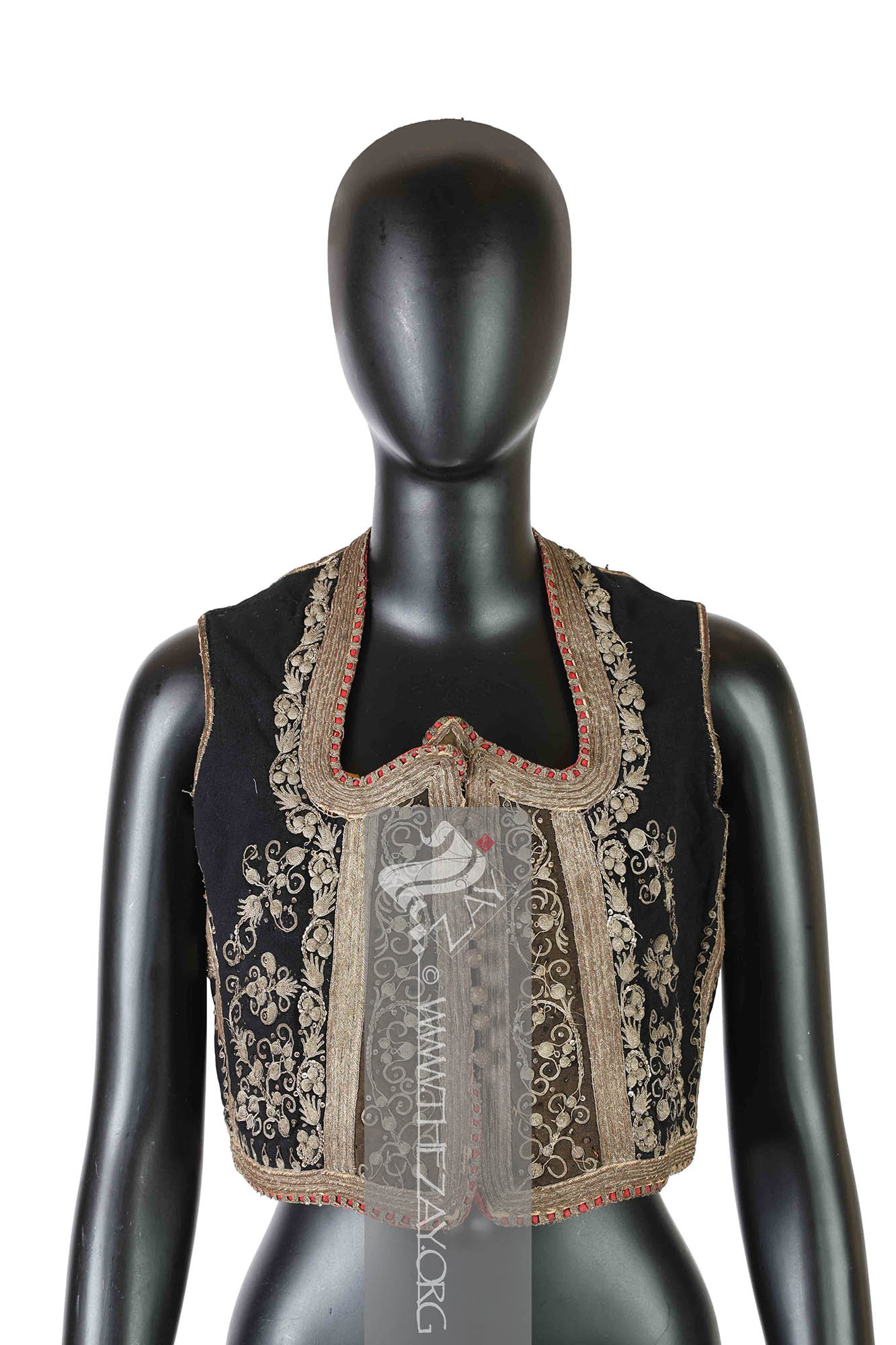
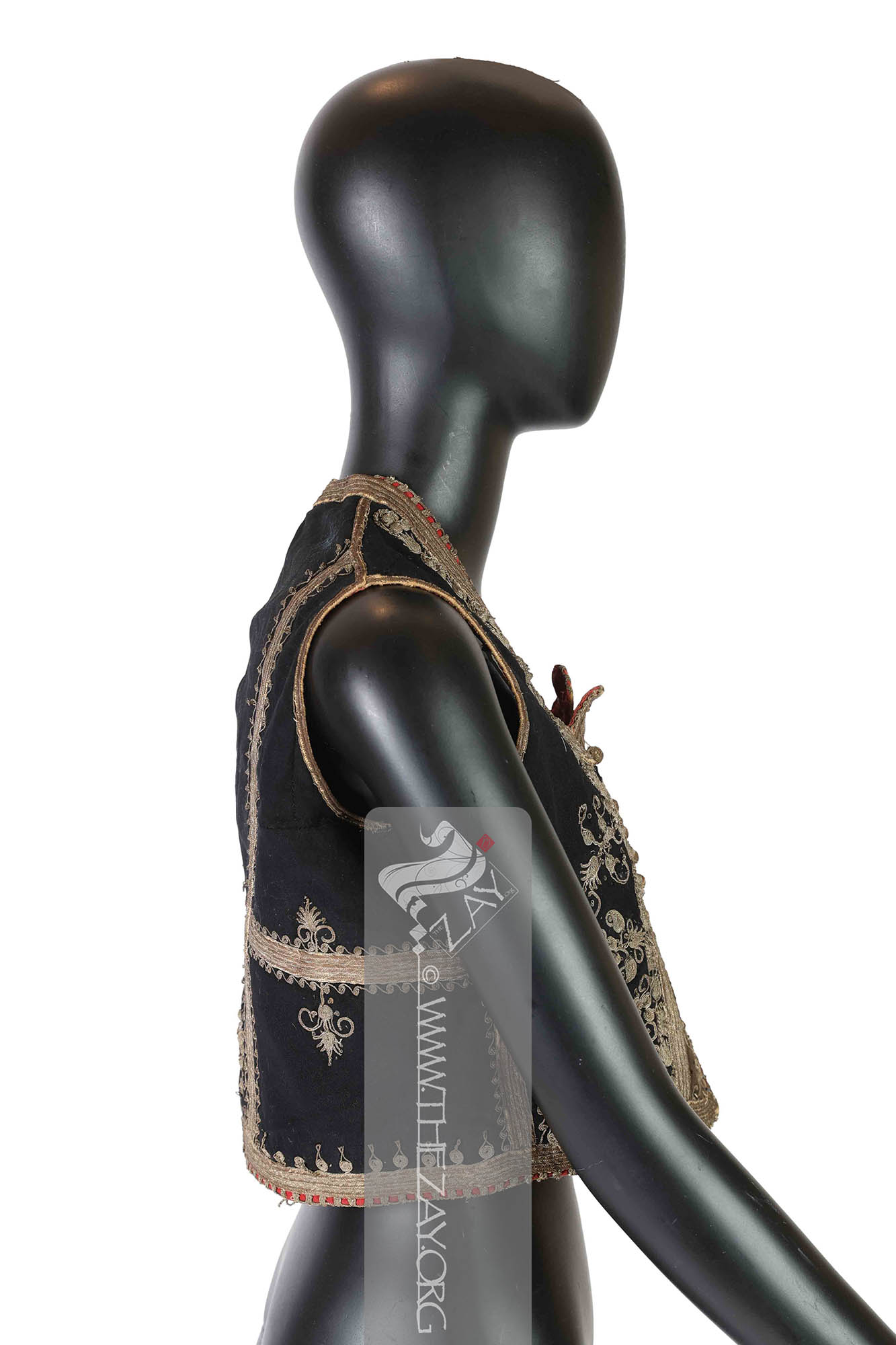
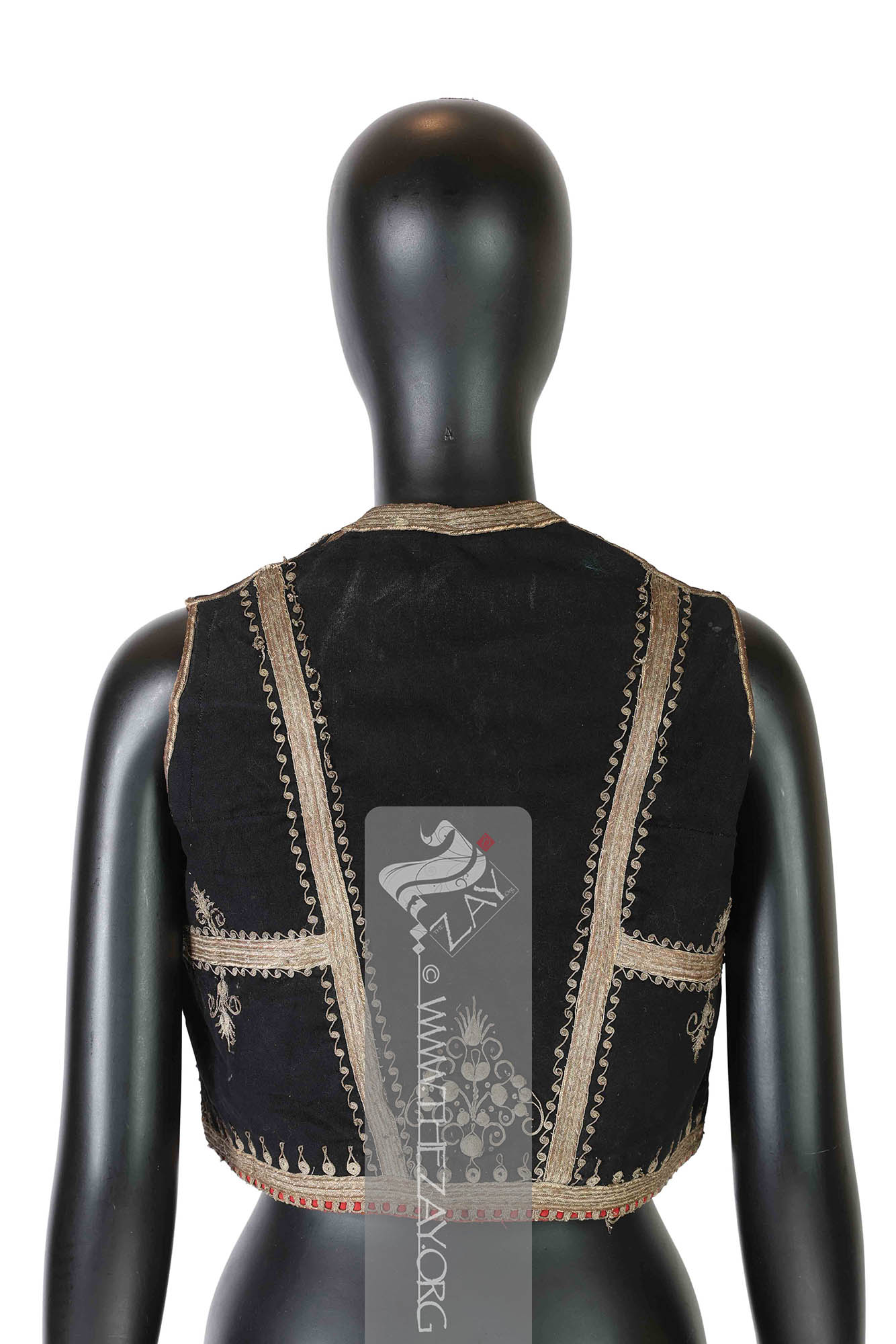
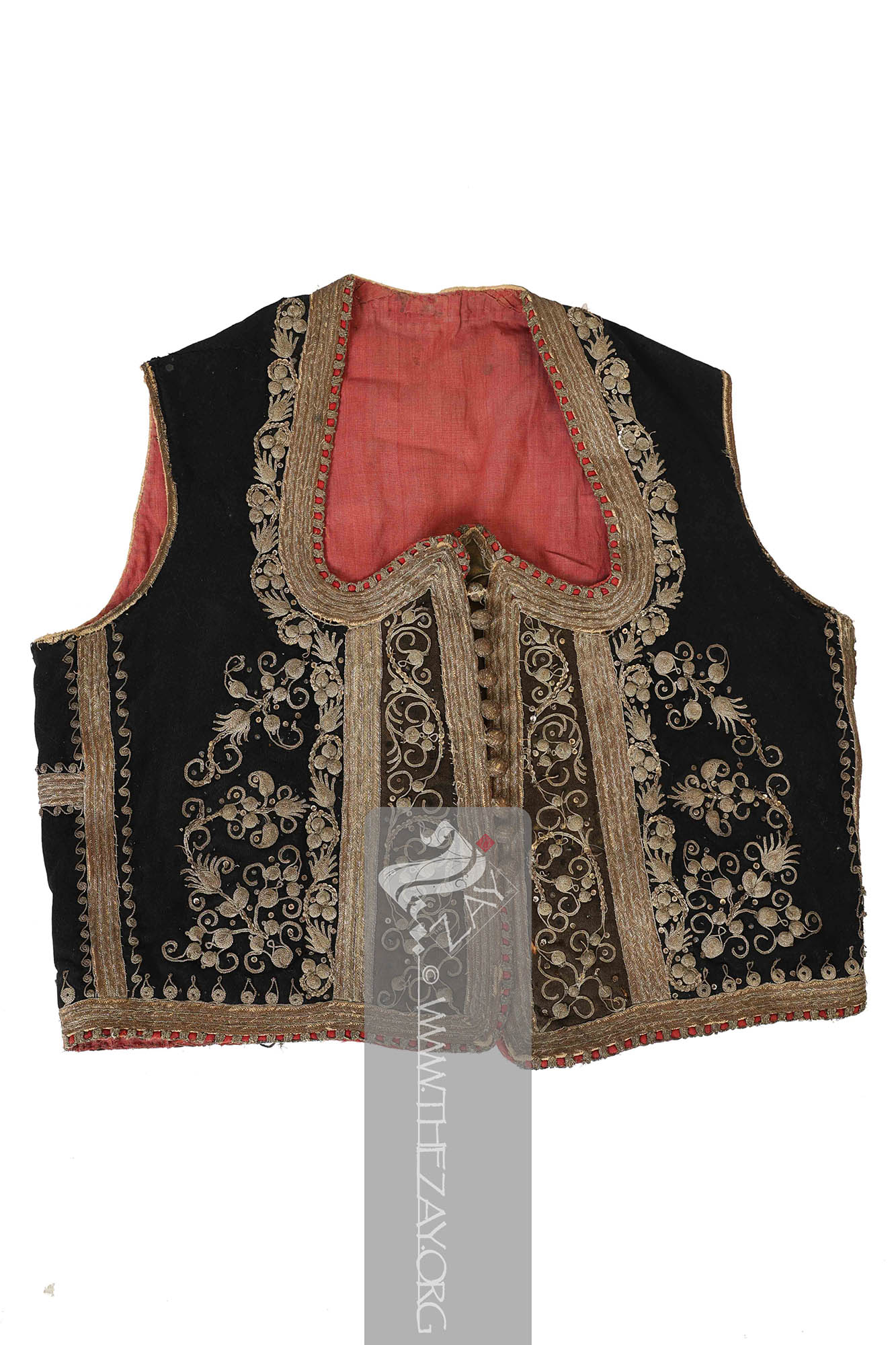
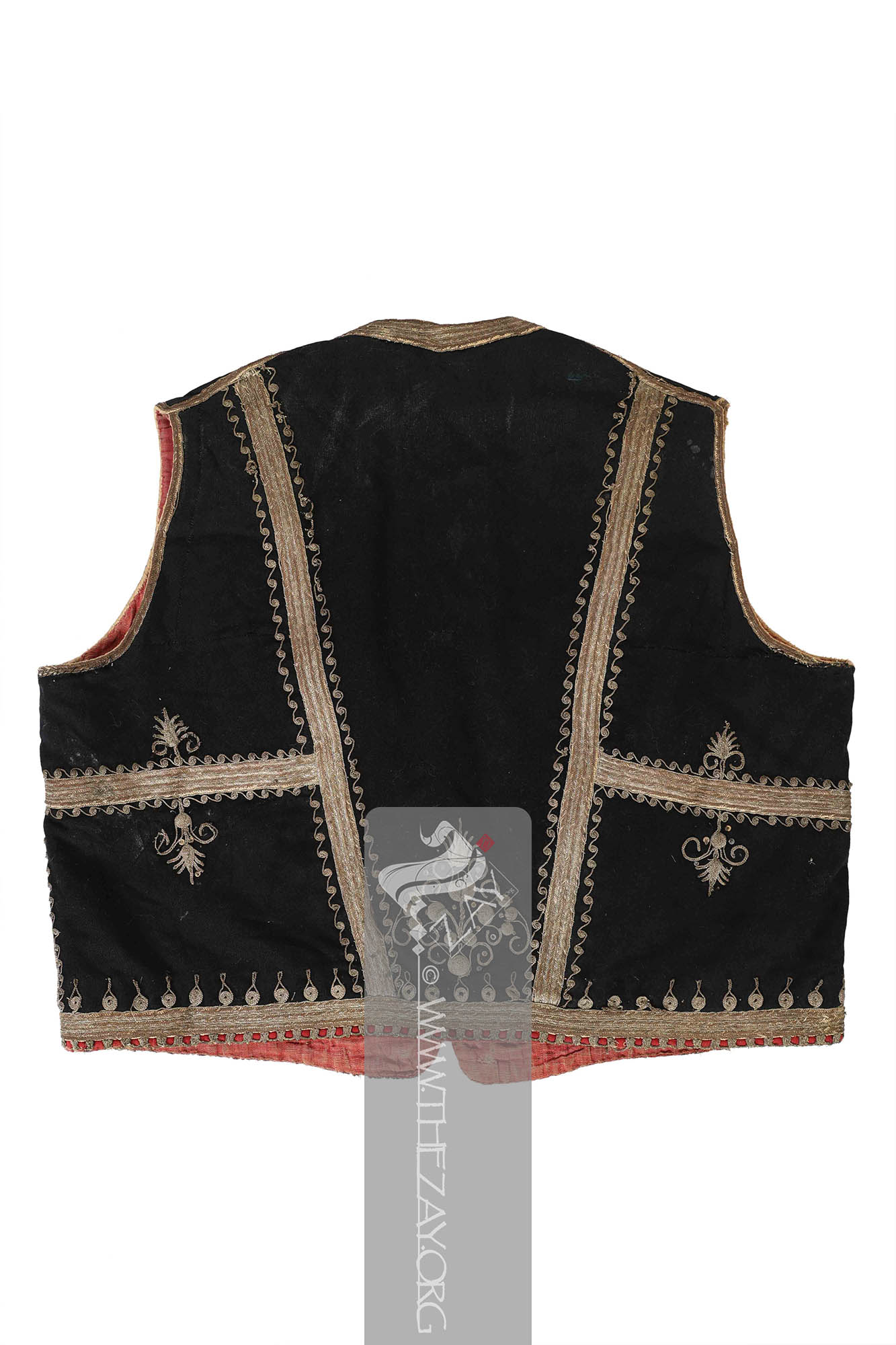
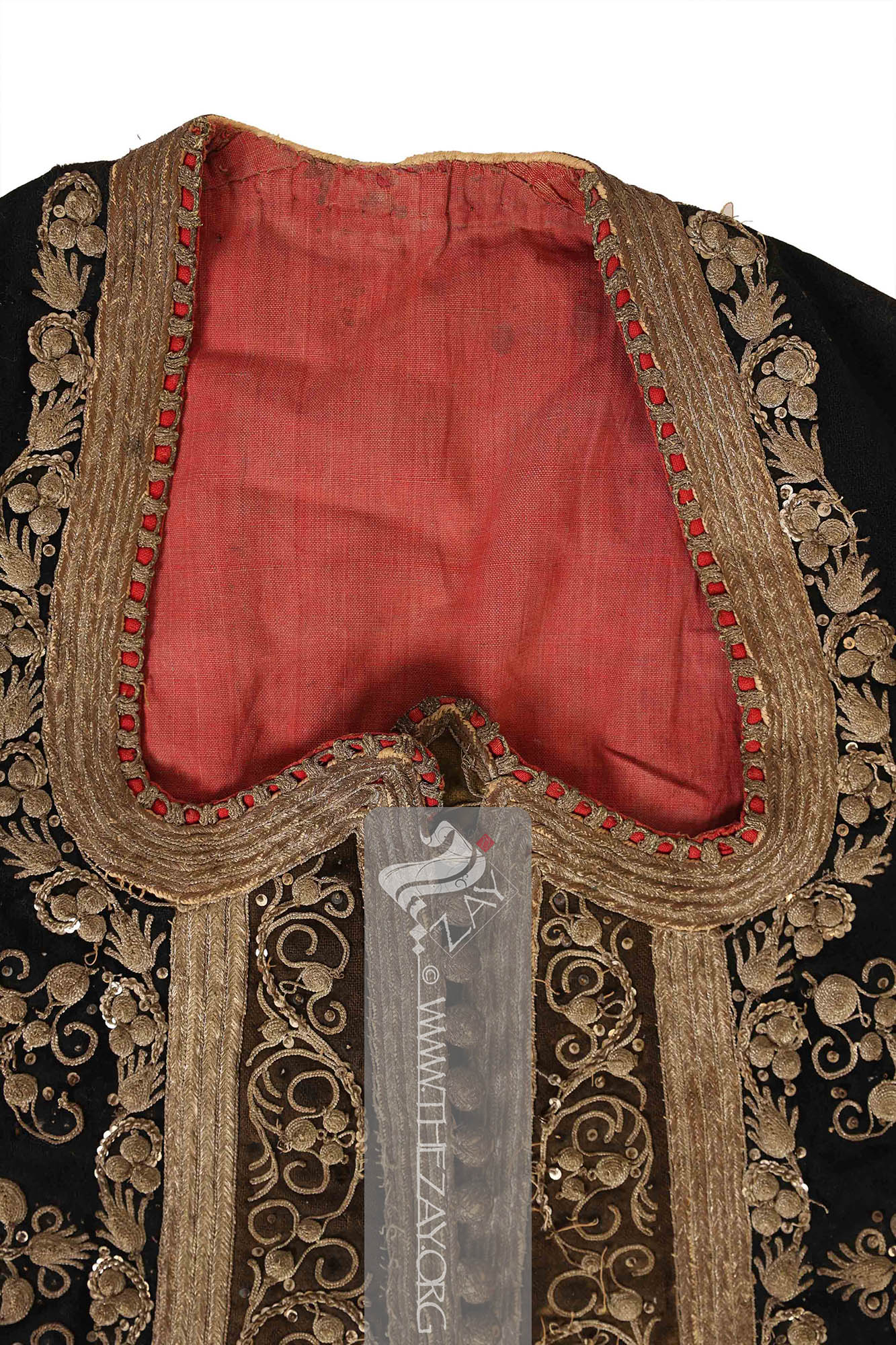
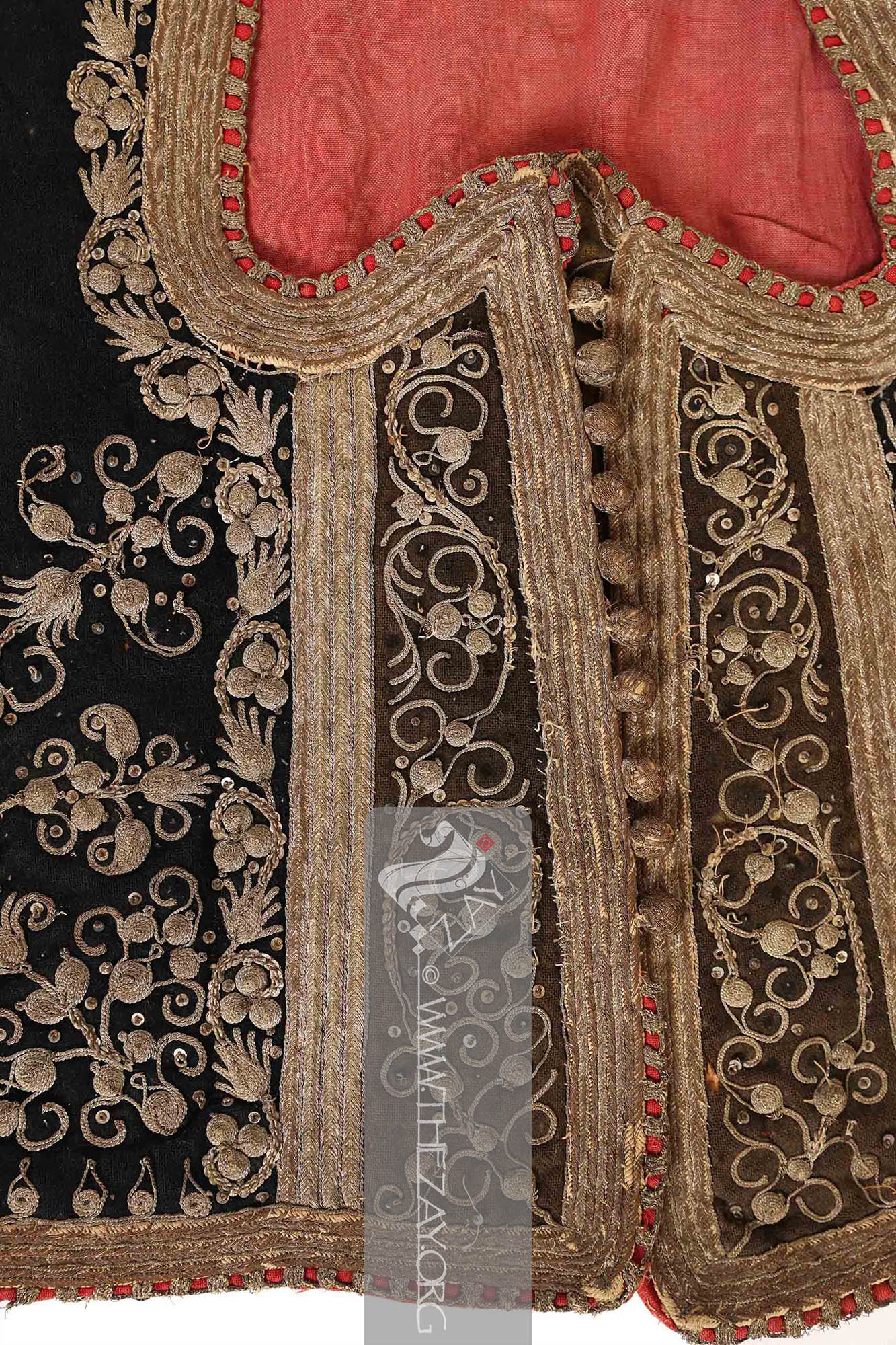
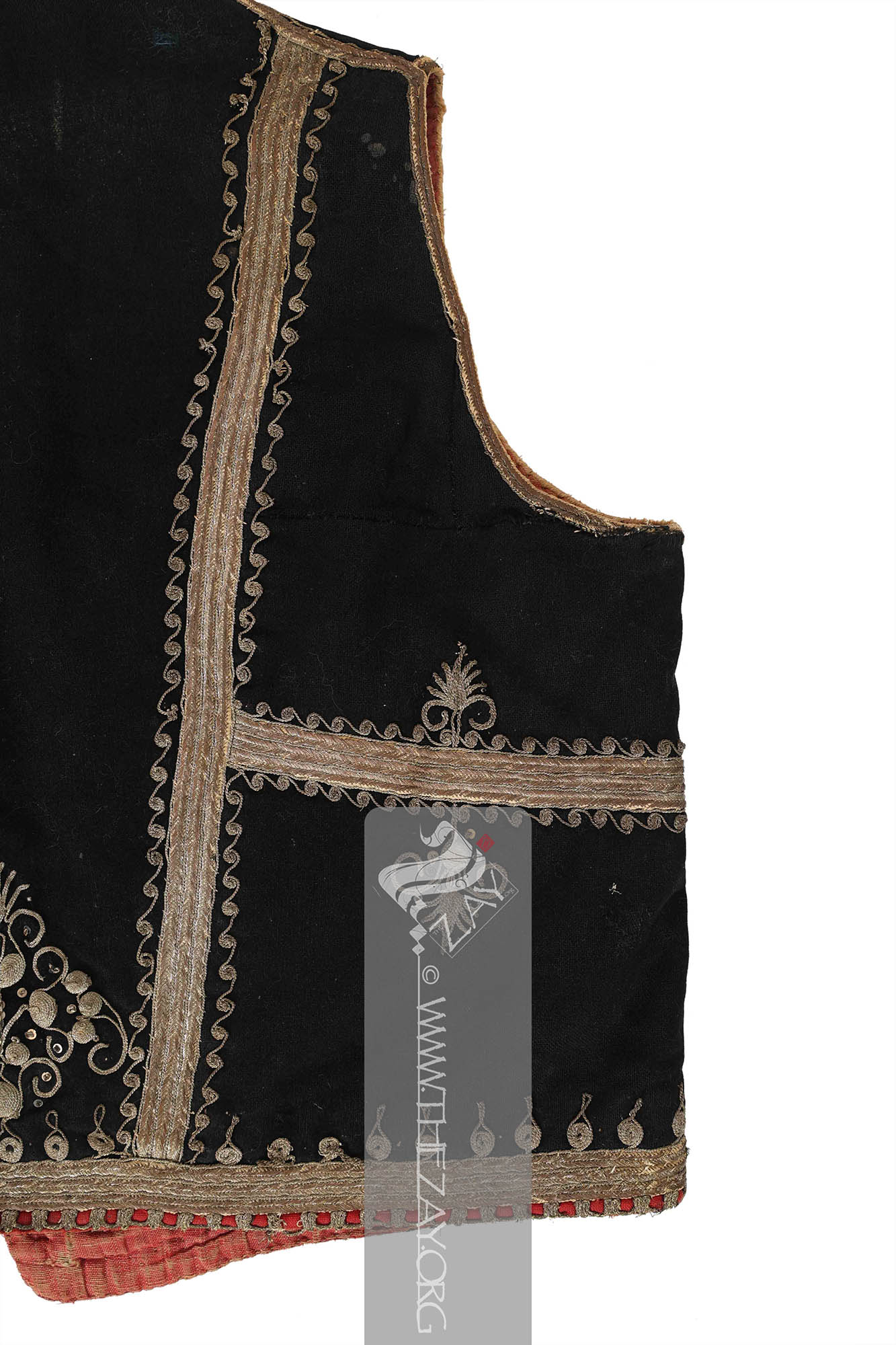
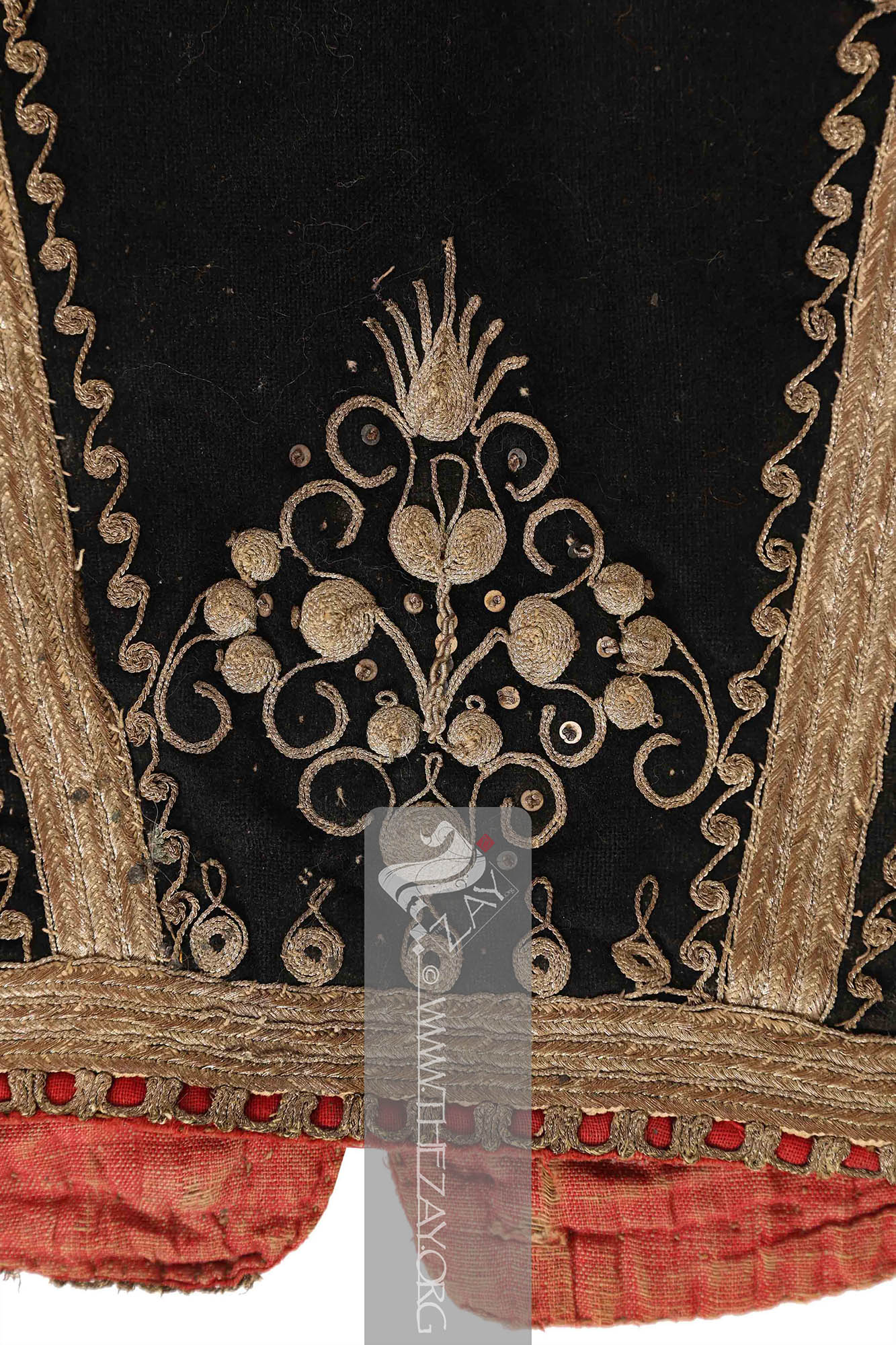
| Local Name | Yelek, Jilek, Jelick |
| Object Category | Overgarment |
| Gender | Female |
| Place Of orgin | Asia |
| Region | Turkey |
| Object Range | Turkey, Syria, Iraq, Lebanon, Kuwait, Palestine, Jordan, Saudi Arabia, Egypt, Sudan, Cyprus, Bulgaria, Romania, Moldova, Greece, North Macedonia, Croatia, Serbia, Bosnia Herzegovina, Kosovo, Armenia, Azerbaijan, Georgia, et al. |
| Dimensions | Length: 42 cm Width: 33 cm |
| Materials | Cotton Metal |
| Technique | Hand Stitched Hand Embroidered |
| Color | |
| Motif | Floral |
| Provenance | Purchased, Dealer, London 2022 |
| Location | The Zay Zay: (Arabic: costume, Pl. azyaā’), a set of clothes in a style typical of a particular country or historical period. Initiative |
| Status | In Storage |
| ZI number | ZI2022.501008.1 ASIA |
Object History
This piece of garment was purchased by Dr. Reem Tariq
Ṭariq: (Arabic; Synonym: tulle_bi_talli; talli; badla; khus_dozi ), series of small metal knots made on a woven net ground as embellishment. The term is commonly used in the Levant Arab region specifically in Lebanon. Ṭariq: (Arabic; Synonym: tulle_bi_talli; talli; badla; khus_dozi ), series of small metal knots made on a woven net ground as embellishment. The term is commonly used in the Levant Arab region specifically in Lebanon.
Object Features
This is a thick black cotton sleeveless women’s waistcoat (yelek Yelek: (Old Anatolian: yélek – Vest; Synonyms: Jelick Jelick: (Old Anatolian: yélek – Vest; Synonyms: Yelek, Jilek Jilek: (Old Anatolian: yélek – Vest; Synonyms: Jelick, Yelek), a short waist or hip length vest traditionally worn by both Ottoman men and women throughout the empire. Ranging from sleeveless to full sleeves, these vests were usually front open and without any fastenings. Often cepken jackets were used as yelek. ), a short waist or hip length vest traditionally worn by both Ottoman men and women throughout the empire. Ranging from sleeveless to full sleeves, these vests were usually front open and without any fastenings. Often cepken jackets were used as yelek. , Jilek Jilek: (Old Anatolian: yélek – Vest; Synonyms: Jelick, Yelek), a short waist or hip length vest traditionally worn by both Ottoman men and women throughout the empire. Ranging from sleeveless to full sleeves, these vests were usually front open and without any fastenings. Often cepken jackets were used as yelek. ), short waist or hip length vest traditionally worn by both Ottoman men and women throughout the empire. Ranging from sleeveless to full sleeves, these vests were usually front open and without any fastenings. Often cepken jackets were used as yelek. ) with heavy metal thread (sirma Sirma: (Byzantine Greek: súrma – a dragging motion, from Ancient Greek: súrō – to draw; Synonym: Tel_sirma Tel_sirma: (Ottoman Turkish: tel – wire, thread, chord; Byzantine Greek: súrma – a dragging motion from Ancient Greek: súrō – to draw; Synonym: Sirma), a metal lace or thread traditionally made of silver or gold and sometimes even copper often used textile embellishments such as embroidery and weaves like brocades. ), a metal lace or thread traditionally made of silver or gold and sometimes even copper often used textile embellishments such as embroidery and weaves like brocades. )/(tel_sirma Tel_sirma: (Ottoman Turkish: tel – wire, thread, chord; Byzantine Greek: súrma – a dragging motion from Ancient Greek: súrō – to draw; Synonym: Sirma), a metal lace or thread traditionally made of silver or gold and sometimes even copper often used textile embellishments such as embroidery and weaves like brocades. ) – silver – embroidery featuring floral motifs and metal, possibly iron hook and eye fasteners.
The field of the yelek
Yelek: (Old Anatolian: yélek – Vest; Synonyms: Jelick
Jelick: (Old Anatolian: yélek – Vest; Synonyms: Yelek, Jilek
Jilek: (Old Anatolian: yélek – Vest; Synonyms: Jelick, Yelek), a short waist or hip length vest traditionally worn by both Ottoman men and women throughout the empire. Ranging from sleeveless to full sleeves, these vests were usually front open and without any fastenings. Often cepken jackets were used as yelek. ), a short waist or hip length vest traditionally worn by both Ottoman men and women throughout the empire. Ranging from sleeveless to full sleeves, these vests were usually front open and without any fastenings. Often cepken jackets were used as yelek. , Jilek
Jilek: (Old Anatolian: yélek – Vest; Synonyms: Jelick, Yelek), a short waist or hip length vest traditionally worn by both Ottoman men and women throughout the empire. Ranging from sleeveless to full sleeves, these vests were usually front open and without any fastenings. Often cepken jackets were used as yelek. ), short waist or hip length vest traditionally worn by both Ottoman men and women throughout the empire. Ranging from sleeveless to full sleeves, these vests were usually front open and without any fastenings. Often cepken jackets were used as yelek. is embellished in (couching
Couching: (Latin: collocare – Place together), in needlework and embroidery couching is a technique in which yarn or other materials are laid across the surface of the ground fabric and fastened in place with small stitches of the same or a different yarn
The wide plackets that feature similar embroidery as the field of the waistcoat are on a brown cotton background and is separated from the main black panel by four lines of braided silver sirma Sirma: (Byzantine Greek: súrma – a dragging motion, from Ancient Greek: súrō – to draw; Synonym: Tel_sirma Tel_sirma: (Ottoman Turkish: tel – wire, thread, chord; Byzantine Greek: súrma – a dragging motion from Ancient Greek: súrō – to draw; Synonym: Sirma), a metal lace or thread traditionally made of silver or gold and sometimes even copper often used textile embellishments such as embroidery and weaves like brocades. ), a metal lace or thread traditionally made of silver or gold and sometimes even copper often used textile embellishments such as embroidery and weaves like brocades. trimming. The same trimming is used for the hem and the neckline.
The right front panel features a series of silver sirma
Sirma: (Byzantine Greek: súrma – a dragging motion, from Ancient Greek: súrō – to draw; Synonym: Tel_sirma
Tel_sirma: (Ottoman Turkish: tel – wire, thread, chord; Byzantine Greek: súrma – a dragging motion from Ancient Greek: súrō – to draw; Synonym: Sirma), a metal lace or thread traditionally made of silver or gold and sometimes even copper often used textile embellishments such as embroidery and weaves like brocades. ), a metal lace or thread traditionally made of silver or gold and sometimes even copper often used textile embellishments such as embroidery and weaves like brocades. knotted faux (frog_fastener
Frog_fastener: (Synonym: Chinese frog closure, frog closure), is a decorative and functional type of button used to fasten clothing. Said to have originated between c. 5th to 7th century China these buttons consist of a cord or braid looped through a decorative knot.
The back of the waistcoat is divided into five panels – a V-shaped central panel with a central floral bouquet embroidered at the lower end and two panels on each side, covering the sides from the end of the central panel to the shoulders one on top of the other.
Each panel is separated with silver braided trimming similar to the front. The four side panels also feature four small floral bouquets mirroring each other. The piece is hand-stitched and is lined with a plain red cotton fabric.
More Info
At its peak, the Ottoman Empire spanned three continents and served as the crossroads between the east and the West – the Fertile Crescent, the Levant, Eastern Europe including the Balkans till the southern edge of the Great Hungarian Plain, Northern Africa and Eastern Mediterranean.
After the conquest of the Arab world in c. 1516-1517 CE its control over the Middle East lasted for four centuries until the early 20th century with the onset of WW I and the Arab Revolt.
These four hundred years witnessed many instances of mutual Arab and Ottoman cultural influences and exchanges.
Through areas such as social life and art – decorative and performing –we come across several instances of Arab and Turkish culture blending together through the centuries.
Just as European fashion was often inspired by the French court this socio-cultural blending between Ottoman Turkey and the Middle East was clearly reflected in its fashion and material culture.
Thus, while emulating Ottoman fashion as the mark of class in the Arab world was one side of the puzzle adapting Eastern European fashion particularly Balkan as part of mainstream couture culture because of the sizeable Balkan population within the Empire was another. Therefore, it is not surprising to find several articles of clothing and their terms similar between these cultures.
Prior to the widespread acceptance of European clothing in the Ottoman Empire, individuals – men and women – residing in urban areas, regardless of their faith or social standing, typically adorned themselves with three primary articles of clothing.
These included a calf-length cotton undershirt or (gömlek Gömlek: (Proto-Turkic: köyŋelek – Shirt; Azerbaijani: köynək – Shirt; Turkmen: koynek – long loose tunic dress), a traditional calf-length sleeved undershirt or tunic generally made of a plain white cotton, silk, or linen fabric, some more lightweight than others, worn by both Ottoman men and women of all communities throughout the empire. ), featuring long sleeves, which was worn over a pair of loose trousers known as (shalvar shalvār: in Farsi, in the Emirati colloquial: ṣarwāl. In the Levantine colloquial: Shirwāl. Plural: sarāwīl, ṣarāwīl, sharāwīl, ṣarwīlāt). It is loose pants at the waist with folds, and narrow at the ankles. It is tied with a rope at the waist.). Additionally, they would wear a long-sleeved robe called an entari Entāri: (Turkish; Synonym: Antari), a traditional Turkish long jacket-like unisex garment worn during the Ottoman era. It often featured an open front with long sleeves and was worn over an undershirt and a pair of trousers and was sometimes layered by a short waist or hip-length jacket. , reaching the ankles or floor. Although, entari Entāri: (Turkish; Synonym: Antari), a traditional Turkish long jacket-like unisex garment worn during the Ottoman era. It often featured an open front with long sleeves and was worn over an undershirt and a pair of trousers and was sometimes layered by a short waist or hip-length jacket. became more and more ceremonial over the period of time older üçetek_entari particularly for travelling served some practical purposes.
Wearers would often fold and tuck the front parts into their waistband, thus creating a layering that would not just look good and assist them in moving around but also create two pouches where the wearer could store food and sometimes small stones to use with slingshots against potential attacks on the road.
Additional layers were added as necessary, based on weather conditions, social occasions, and social status. These layers encompassed items such as waistcoats (cepken Cepken: (Tartar: çepken – Outerwear; Synonyms: Shepken, Chekman, Chikmyan and other analogues in various Turkic languages with varied interpretations), short waist-length jacket traditionally worn by both Ottoman men and women throughout the empire. It usually featured full sleeves, elaborate embroidery, and a short stiff collar with front fastenings. ), short jackets (yelek Yelek: (Old Anatolian: yélek – Vest; Synonyms: Jelick Jelick: (Old Anatolian: yélek – Vest; Synonyms: Yelek, Jilek Jilek: (Old Anatolian: yélek – Vest; Synonyms: Jelick, Yelek), a short waist or hip length vest traditionally worn by both Ottoman men and women throughout the empire. Ranging from sleeveless to full sleeves, these vests were usually front open and without any fastenings. Often cepken jackets were used as yelek. ), a short waist or hip length vest traditionally worn by both Ottoman men and women throughout the empire. Ranging from sleeveless to full sleeves, these vests were usually front open and without any fastenings. Often cepken jackets were used as yelek. , Jilek Jilek: (Old Anatolian: yélek – Vest; Synonyms: Jelick, Yelek), a short waist or hip length vest traditionally worn by both Ottoman men and women throughout the empire. Ranging from sleeveless to full sleeves, these vests were usually front open and without any fastenings. Often cepken jackets were used as yelek. ), short waist or hip length vest traditionally worn by both Ottoman men and women throughout the empire. Ranging from sleeveless to full sleeves, these vests were usually front open and without any fastenings. Often cepken jackets were used as yelek. ), extra entari Entāri: (Turkish; Synonym: Antari), a traditional Turkish long jacket-like unisex garment worn during the Ottoman era. It often featured an open front with long sleeves and was worn over an undershirt and a pair of trousers and was sometimes layered by a short waist or hip-length jacket. , as well as coats of various sizes and lengths.
Belts adorned with elaborate embroidery and ornate buckles, or just embroidered sashes as (cummerbund Cummerbund: (Anglicized from Hindustani: kamarband kamarband: (Persian: kamarband – a waistband or sash tied around the waist, synonym: cummerbund), a broad sash worn around the waist by men. In the 17th century, the British Indian Army adopted this style from the Indian sepoys and made it a part of the English lexicon. from Persian: kamarband kamarband: (Persian: kamarband – a waistband or sash tied around the waist, synonym: cummerbund), a broad sash worn around the waist by men. In the 17th century, the British Indian Army adopted this style from the Indian sepoys and made it a part of the English lexicon. – a waistband or sash tied around the waist), a broad sash worn around the waist by men. In the 17th century the British Indian Army adopted this style from the Indian sepoys and made it a part of the English lexicon. ) were utilized to accentuate the bust, waist, and hips, creating a defined silhouette.
Although, the entari Entāri: (Turkish; Synonym: Antari), a traditional Turkish long jacket-like unisex garment worn during the Ottoman era. It often featured an open front with long sleeves and was worn over an undershirt and a pair of trousers and was sometimes layered by a short waist or hip-length jacket. was common throughout the Ottoman empire, layering with a cepken Cepken: (Tartar: çepken – Outerwear; Synonyms: Shepken, Chekman, Chikmyan and other analogues in various Turkic languages with varied interpretations), short waist-length jacket traditionally worn by both Ottoman men and women throughout the empire. It usually featured full sleeves, elaborate embroidery, and a short stiff collar with front fastenings. and a yelek Yelek: (Old Anatolian: yélek – Vest; Synonyms: Jelick Jelick: (Old Anatolian: yélek – Vest; Synonyms: Yelek, Jilek Jilek: (Old Anatolian: yélek – Vest; Synonyms: Jelick, Yelek), a short waist or hip length vest traditionally worn by both Ottoman men and women throughout the empire. Ranging from sleeveless to full sleeves, these vests were usually front open and without any fastenings. Often cepken jackets were used as yelek. ), a short waist or hip length vest traditionally worn by both Ottoman men and women throughout the empire. Ranging from sleeveless to full sleeves, these vests were usually front open and without any fastenings. Often cepken jackets were used as yelek. , Jilek Jilek: (Old Anatolian: yélek – Vest; Synonyms: Jelick, Yelek), a short waist or hip length vest traditionally worn by both Ottoman men and women throughout the empire. Ranging from sleeveless to full sleeves, these vests were usually front open and without any fastenings. Often cepken jackets were used as yelek. ), short waist or hip length vest traditionally worn by both Ottoman men and women throughout the empire. Ranging from sleeveless to full sleeves, these vests were usually front open and without any fastenings. Often cepken jackets were used as yelek. over a gömlek Gömlek: (Proto-Turkic: köyŋelek – Shirt; Azerbaijani: köynək – Shirt; Turkmen: koynek – long loose tunic dress), a traditional calf-length sleeved undershirt or tunic generally made of a plain white cotton, silk, or linen fabric, some more lightweight than others, worn by both Ottoman men and women of all communities throughout the empire. and a pair of loose shalvar shalvār: in Farsi, in the Emirati colloquial: ṣarwāl. In the Levantine colloquial: Shirwāl. Plural: sarāwīl, ṣarāwīl, sharāwīl, ṣarwīlāt). It is loose pants at the waist with folds, and narrow at the ankles. It is tied with a rope at the waist. was most common in the Balkan regions, an influence that widely spread through the rest of the Ottoman Empire and was especially popular in c. late 19thand early 20th centuries in the north-western provinces such as the Marmara region in present-day Türkiye, as it had a significant Balkan population.
Links